The Pacific Decadal Oscillation (PDO) and El Niño Southern Oscillation
(ENSO) influence sea surface temperatures, sea level pressure, and surface
winds in very similar ways. The most obvious difference between the
PDO and ENSO is the time scale. Whereas ENSO events tend to persist
on the order of one year, the PDO signature can last up to 30 years
(Mantua, 2001).
Additionally, while the PDO primarily affects the North Pacific region,
its effects can be felt near the equator. Conversely, ENSO primarily affects
the climate of lower latitudes, but its secondary effects are felt in
the North Pacific (Mantua, 2001). A positive, or
warm
phase PDO, produces climate and circulation patterns that are very
similar to El Niño. Likewise, a negative, or
cool
phase PDO, produces climate and circulation patterns similar to La
Niña (Gershunov and Barnett, 1998). This is documented in the following
two figures, which show how sea surface temperatures and surface winds
are influenced by (1) the positive and negative phases of the PDO and
(2) El Niño and La Niña phases of ENSO. Dark red and dark
blue indicate temperature anomalies of +0.8 C and -0.6 C, respectively.
Wind stress directions and magnitudes are indicated by vectors.

Source:
Mantua,
2000
Numerous studies have attempted to determine the effect
of the PDO and ENSO on each other. The results have been largely inconclusive
and/or contradictory. However, a study by Gershunov and Barnett (1998)
shows that the PDO has a modulating effect on the climate patterns resulting
from ENSO. The climate signal of El Niño is likely to be stronger
when the PDO is highly positive; conversely the climate signal of La
Niña will be stronger when the PDO is highly negative. This does
not mean that the PDO physically controls ENSO, but rather that the
resulting climate patterns interact with each other.
